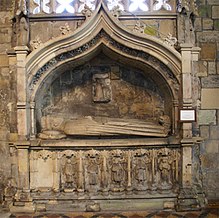Art in Medieval Scotland
Pictish art was the only uniquely Scottish medieval style; it can be seen in the extensive survival of carved stones, particularly in the north and east of the country, which hold a variety of recurring images and patterns.Much of the best Scottish artwork of the High and Late Middle Ages was either religious in nature or realised in metal and woodwork, and has not survived the impact of time and the Reformation.[2] Class II stones are carefully shaped slabs dating after the arrival of Christianity in the eighth and ninth centuries, with a cross on one face and a wide range of symbols on the reverse.[4] Thomas Charles-Edwards has suggested that the kingdom of Dál Riata was a cross-roads between the artistic styles of the Picts and those of Ireland, with which the Scots settlers in what is now Argyll kept close contacts.Other isolated finds include a gold object from Dalmeny, shaped like a truncated pyramid, with filigree and garnet, similar to sword harness mounts found at Sutton Hoo.[16] None of the major insular manuscripts, like the Book of Kells, have preserved their elaborate jewelled metal covers, but documentary evidence indicates that these were as spectacular as the few remaining continental examples.In the east the influence of Pictish sculpture can be seen, in areas of Viking occupation and settlement, crosses for the tenth to the twelfth centuries have distinctive Scandinavian patterns, often mixed with native styles.[24] From the west, another boat burial at Kiloron Bay in Colonsay revealed a sword, shield, iron cauldron and enamelled scales, which may be Celtic in origin.Examples include the eleventh-century cross-slab from Dóid Mhàiri on the island of Islay, where the plant motifs on either side of the cross-shaft are based upon the Ringerike style of Viking art.[28] The most famous artistic find from modern Scotland, the Lewis Chessmen, from Uig, were probably made in Trondheim in Norway, but contain some decoration that may have been influenced by Celtic patterns.[31] Much of the best Scottish artwork of the High and Late Middle Ages was either religious in nature or realised in metal and woodwork and has not survived the impact of time and the Reformation.[32] However, examples of sculpture are extant as part of church architecture, a small number of significant crafted items have also survived and, for the end of the period, there is evidence of painting, particularly the extensive commissioning of works in the Low Countries and France.[34] The carvings at Rosslyn Chapel, created in the mid-fifteenth century, elaborately depicting the progression of the seven deadly sins, are considered some of the finest in the Gothic style.[34] Sometimes the best continental artists were employed, as for Robert I's elaborate tomb in Dunfermline Abbey, which was made in his lifetime by the Parisian sculptor Thomas of Chartres, but of which only fragments now survive.[32] The greatest group of surviving sculpture from this period are from the West Highlands, beginning in the fourteenth century on Iona under the patronage of the Lordship of the Isles and continuing until the Reformation.[41] Key examples of native craftsmanship on items include the Bute mazer, the earliest surviving drinking cup of its type, made of maple-wood and with elaborate silver-gilt ornamentation, dated to around 1320.[44] One of the largest groups of surviving works of art are the seal matrices that appear to have entered Scottish usage with feudalism in the reign of David I, beginning at the royal court and among his Anglo-Norman vassals and then by about 1250 they began to spread to the Gaelicised areas of the country.








Aberlemnoearly Middle AgesPictish artuniquely ScottishDál RiataInsular artRomanesqueGothichigh crossesBook of KellsCeltic artPictish stonesDunnichen Stonedouble disc and z-rodmirror and combPictish beastFirth of ForthShetlandDunrobinGlamisCeltic crosshacksilverTraprain LawWhitecleuch ChainSt Ninian's IsleIrish artHunterston BroochHunterstonNorth AyrshireThomas Charles-Edwardsbroochespseudo-penannularMonymusk ReliquaryAnglo-Saxon artFranks CasketNorthumbriaDalmenyfiligreegarnetSutton HooYetholmCulbin SandsBurgheadChristianisationGospel of Johnilluminated manuscriptsBook of DurrowCarpet pageshistoriated initialscanon tablesEvangelist portraitsshrinescumdachsrelicsrock crystalgarnetsenamelmillefioriKildalton CrossRuthwell CrossHiberno-Scottish missionViking Age artLewis chessmenScar boat burialColonsaypenannular broochRingerike styleTrondheimArchitecture in Medieval ScotlandArchibald, 5th earl of DouglasDouglasEnglish perpendicularRosslyn Chapelseven deadly sinsRobert IDunfermline AbbeyLordship of the IslesSculpture in ScotlandScottish ReformationLimoges enamelsfleuronsegg and dartreliefstrapworkBute mazerSavernake HornreliquariesCeltic churchreliquaryGuthriewalrusGaelicisedSt AndrewsGlasgowTrinity AltarpieceHugo van der GoesTrinity College KirkKelso AbbeyDoom paintingArbroathNorthern RenaissanceWilliam ElphinstoneBishop of AberdeenDunkeldTrinity College Church in EdinburghJames IIIMaster of James IV of ScotlandRobert BlackadderBishop of Glasgowbook of hoursHours of James IV of ScotlandJames IVMargaret TudorArchitecture of ScotlandMedieval artJ. Graham-CampbellC. R. DodwellMuseum of ScotlandScotland in the Middle AgesSub-RomanHigh Middle AgesLate Middle AgesBamburghBerniciaFortriuGalloway